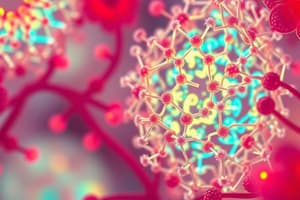Podcast
Questions and Answers
What is the unit of measurement used for greater magnification on a microscope?
What is the unit of measurement used for greater magnification on a microscope?
- Micrometers (correct)
- Nanometers
- Millimeters
- Centimeters
What is the name of the technique used to reach atomic resolution in microscopy?
What is the name of the technique used to reach atomic resolution in microscopy?
- Scanning power microscopy
- Light microscopy
- Cryo-electron microscopy (correct)
- Low power microscopy
What is the unit of measurement used for distances across the field of view on scanning power?
What is the unit of measurement used for distances across the field of view on scanning power?
- Micrometers
- Millimeters (correct)
- Nanometers
- Centimeters
What is the correct sequence of steps to follow when finished using the microscope?
What is the correct sequence of steps to follow when finished using the microscope?
What is the typical magnification of most eyepieces?
What is the typical magnification of most eyepieces?
What is the approximate limit of resolution of the naked eye?
What is the approximate limit of resolution of the naked eye?
What is the formula used to calculate the limit of resolution of a microscope?
What is the formula used to calculate the limit of resolution of a microscope?
What is the effect of increasing the numerical aperture (N.A.) on the resolving power of a microscope?
What is the effect of increasing the numerical aperture (N.A.) on the resolving power of a microscope?
What is the approximate improvement in resolving power of a high-quality microscope compared to the naked eye?
What is the approximate improvement in resolving power of a high-quality microscope compared to the naked eye?
What is the primary reason why we need to use microscopes to study cells?
What is the primary reason why we need to use microscopes to study cells?
What is the name of the technique used by biologists to observe live samples in real time?
What is the name of the technique used by biologists to observe live samples in real time?
What is the limitation of light microscopy?
What is the limitation of light microscopy?
What is the name of the field of using microscopes to view samples or specimens?
What is the name of the field of using microscopes to view samples or specimens?
What are the two types of microscopes named according to the source of illumination used?
What are the two types of microscopes named according to the source of illumination used?
What is the purpose of using fluorescent molecules in fluorescence microscopy?
What is the purpose of using fluorescent molecules in fluorescence microscopy?
Flashcards are hidden until you start studying
Study Notes
Microscopy and Cells
- Millimeters (mm) measure distances across the field of view on scanning power, whereas micrometers (μm) are used for greater magnification.
- Fields of view and approximate distances across for scanning, low, and high power are:
- Scanning power: 4 mm
- Low power: 1.2 mm
- High power: 0.3 mm
Magnification and Resolution
- Typical magnifications available with a set of objectives are 10x (low power), 40x (high power), and 100x (oil immersion).
- Eyepieces usually have a magnification between 8x and 12.5x.
- The resolution and numerical aperture of the microscope allow for the exposure of subunits within the sample.
- The microscope's resolving power is determined by the limit of resolution (l.r.), which specifies the smallest distance at which two neighboring points can still be observed as separate entities.
- The limit of resolution for a microscope is calculated using the Abbe equation: l.r. = 0.61 λ / N.A.
Limit of Resolution
- The l.r. of the naked eye is approximately 0.1 mm.
- A high-quality microscope has an l.r. of about 0.2 μm, providing a 500-fold improvement.
- The limit of resolution is indirectly proportional to N.A.
- As N.A. increases, the resolving power of the microscope also increases.
Cell Biology
- Cells are considered to be the fundamental building block of all biological life.
- Cells possess all the necessary characteristics of life, making them critical to our understanding of the processes that govern living organisms.
- The study of cells is indispensable to the study of life itself.
Microscopy
- Microscopy is the technical field of using microscopes to view samples or specimens.
- Two types of microscopes are named according to the source of illumination used: light microscopes and electron microscopes.
- Light microscopy employs visible light to detect small objects.
- Examples of light microscopy include bright, dark, phase-contrast, and fluorescence microscopy.
- Fluorescence microscopy is a technique used to observe live samples in real time.
- It involves using fluorescent molecules to tag and light up target cells or cellular components, mostly proteins.
Studying That Suits You
Use AI to generate personalized quizzes and flashcards to suit your learning preferences.




